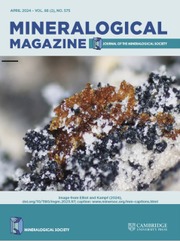No CrossRef data available.
Article contents
The synthetic analogue of kotulskite and its solid-solution series with selected elements
Published online by Cambridge University Press: 31 January 2025
Abstract
The solubility of Ag, As, Bi, Cu, Pb, Sb and Sn in the synthetic analogue of kotulskite (PdTe) was studied experimentally at 400°C (for Bi at 500°C). The extent of the solid solution was studied on the line PdTe–PdA with a compositional range Pd(Te1–xAx) with x = 0.1, 0.2, 0.4 and 0.6 and A = Ag, As, Bi, Cu, Pb, Sb and Sn. For the purpose of this study the silica-glass tube method was used. The experimental products were evaluated by means of powder X-ray diffraction analysis, reflected light and electron microscopy. Kotulskite does not dissolve Ag. It may dissolve up 3 at.% As, up to 5.6 at.% Cu, up to 20 at.% Sn and up to 30 at.% Pb. A complete solid solution between kotulskite (PdTe) – sudburyite (PdSb) and kotulskite (PdTe) – sobolevskite (PdBi) as suggest from natural occurrences has not been confirmed within this study. There is a composition gap between Pd0.99(Te0.21Bi0.80)Σ1.01 (PdTe dissolving 40.3 at.% Bi) and Pd1.00(Bi0.97Te0.03)Σ1.00 (PdBi dissolving 1.6 at.% Te). Also, there seems to be a gap between Pd1.00(Te0.18Sb0.82)Σ1.00 (PdTe dissolving 41.1 at.% Sb) and PdSb. The Cu substitutes for Pd whereas As, Bi, Pb, Sb and Sn substitute for Te in the crystal structure of kotulskite. Assessed solid solution series should be sought in assemblages with other platinum-group minerals and known Pd tellurides, likely in magmatic Cu–Ni–PGE mineral deposits, associated with mafic and ultramafic igneous rocks.
Information
- Type
- Article
- Information
- Copyright
- © The Author(s), 2025. Published by Cambridge University Press on behalf of The Mineralogical Society of the United Kingdom and Ireland.
Footnotes
Associate Editor: David Hibbs

